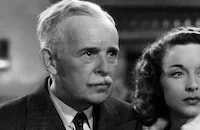We Who Are About to Die

Brief Synopsis
Cast & Crew
Christy Cabanne
Preston Foster
Ann Dvorak
John Beal
Ray Mayer
Gordon Jones
Film Details
Technical Specs

Synopsis
After his designs for a new aircraft are rejected by his conservative boss, engineer John E. Thompson quits his job and makes plans with his fiancée, travel agent Connie Stewart, to leave New Mexico for California. While on his way to pick up his last paycheck, John is ambushed by gangsters, who steal his car and use it and his company coat to rob the payroll office. During the hold-up, the paymaster is killed by "Mac" MacAndrews, the gang's leader, and a little boy is run over as the gangsters make their escape. The gangsters dump John's car and release John, who then is arrested by the police. Implicated by the physical evidence, John is convicted of the crimes by Knight, an ambitious district attorney, and by the revenge-hungry public, and is sentenced to hang. Sure that John is innocent, Connie convinces police detective Steven Mathews, who had helped to convict John, to re-interview a guard who had been injured during the robbery. When the guard relates a story different from his trial testimony, Steven suspects that John was framed and pursues a new investigation of his case. In prison, John grows increasingly despondent and skeptical as his death row neighbors leave for the gallows one by one. Unknown to him, however, two of the gangsters, Bright Boy Schultz and Clyde Beasley, also have been framed by a greedy Mac and are serving time in the same prison. Filled with guilt, Bright Boy sends a message through the prison pipes to John that he knows the identity of the real killer. Bright Boy is unable to finish his message, however, and an hysterical John is sent to the "hole." After Clyde stabs Bright Boy to death in the prison yard, Steven drugs Clyde and drags Mac's name out of him. In spite of Steven's mounting evidence against Mac, the governor refuses to stay John's approaching execution. On the same day that John is to die, Mac poisons his double-crossing cohort, Nick Trotti, and takes off for Chicago with the payroll money. As John's neighbors stage a violent protest in their cellblock, Steven and Knight catch Mac with Nick's corpse and the stolen cash. With minutes to spare, John is saved from execution, and exonerated, he leaves for California with Connie.

Director

Christy Cabanne
Cast

Preston Foster

Ann Dvorak

John Beal
Ray Mayer

Gordon Jones

Russell Hopton

J. Carrol Naish
Paul Hurst
Frank Jenks

John Wray
Frank M. Thomas
Barnett Parker
Willie Fung

John Carroll

Dewitt Jennings
Landers Stevens
John "skins" Miller

Howard Hickman
Robert E. O'connor

Willie Best

Russell Hicks

Wilfred Lucas
Oscar Apfel
Tom Mcguire

Bryant Washburn
Edward Lesaint
Sonny Bupp
Crew
James Anderson
Samuel J. Briskin
Denzil A. Cutler
Feild Gray
Paul Perez
Robert Planck
Van Nest Polglase
Arthur Roberts
William N. Robson
Edward Small
John Twist

Film Details
Technical Specs

Articles
We Who Are About to Die
By Frank Miller

We Who Are About to Die
Quotes
Trivia
Notes
The working titles of this film were One Man Came Back and Condemned Row. David Lamson, on whose book this film is based, served thirteen months in San Quentin Penitentiary before the Supreme Court reversed his murder conviction, according to New York Times. According to Hollywood Reporter, Lamson, who was accused of murdering his wife, endured three trials before being declared innocent. A Hollywood Reporter production news item adds Bruce Mitchell and Philip Morris to the cast, but their participation in the final film has not been confirmed.














